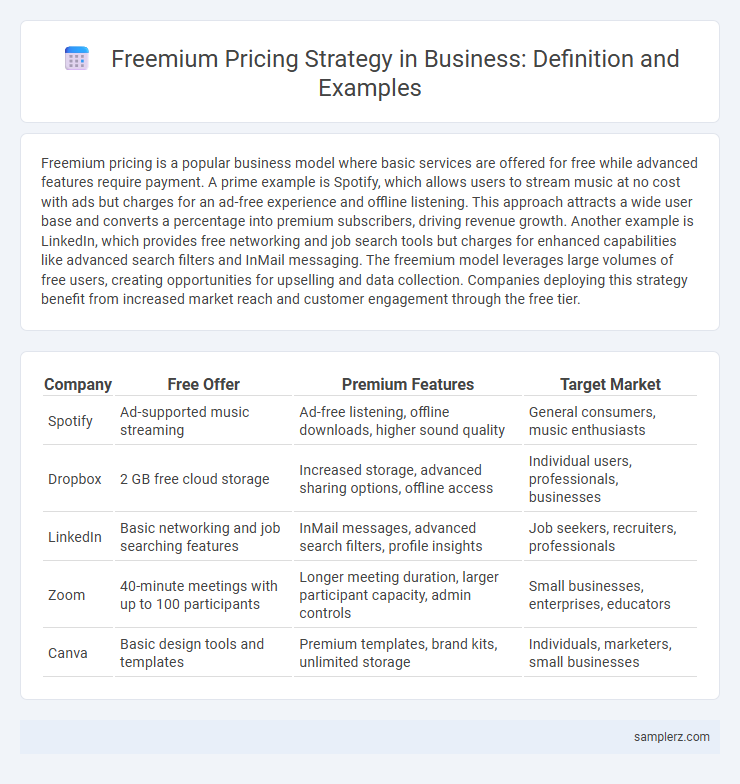Freemium pricing is a popular business model where basic services are offered for free while advanced features require payment. A prime example is Spotify, which allows users to stream music at no cost with ads but charges for an ad-free experience and offline listening. This approach attracts a wide user base and converts a percentage into premium subscribers, driving revenue growth. Another example is LinkedIn, which provides free networking and job search tools but charges for enhanced capabilities like advanced search filters and InMail messaging. The freemium model leverages large volumes of free users, creating opportunities for upselling and data collection. Companies deploying this strategy benefit from increased market reach and customer engagement through the free tier.
Table of Comparison
| Company | Free Offer | Premium Features | Target Market |
|---|---|---|---|
| Spotify | Ad-supported music streaming | Ad-free listening, offline downloads, higher sound quality | General consumers, music enthusiasts |
| Dropbox | 2 GB free cloud storage | Increased storage, advanced sharing options, offline access | Individual users, professionals, businesses |
| Basic networking and job searching features | InMail messages, advanced search filters, profile insights | Job seekers, recruiters, professionals | |
| Zoom | 40-minute meetings with up to 100 participants | Longer meeting duration, larger participant capacity, admin controls | Small businesses, enterprises, educators |
| Canva | Basic design tools and templates | Premium templates, brand kits, unlimited storage | Individuals, marketers, small businesses |
Understanding Freemium Pricing Models
Freemium pricing models offer basic services or products for free while charging for premium features, creating a scalable customer acquisition strategy widely used in software and digital services sectors. Popular examples include Spotify, which provides free music streaming with ads and limited skips, while premium subscriptions remove ads and offer offline listening. This model leverages user base growth through free access, converting a fraction of users into paying customers to generate sustainable revenue.
Key Benefits of Freemium Strategies for Businesses
Freemium pricing models enable businesses to attract a broad user base by offering essential services at no cost while monetizing premium features, increasing customer acquisition and retention rates. This strategy enhances market penetration and provides valuable user data for product development and targeted marketing. Companies like Spotify and Dropbox leverage freemium to drive scalable growth and maximize lifetime customer value.
Classic Examples of Freemium Pricing in Tech
Spotify exemplifies freemium pricing by offering free access to its music library with ads while premium subscribers enjoy ad-free listening and offline playback. LinkedIn provides a basic free professional networking platform, with paid tiers offering advanced job search tools and profile insights. Dropbox uses freemium by giving limited free cloud storage and charging for additional space and premium collaboration features.
SaaS Companies Succeeding with Freemium
SaaS companies like Dropbox and Slack exemplify success with the freemium pricing model by offering basic services at no cost while generating revenue from premium features and increased storage. This strategy drives user acquisition, fosters brand loyalty, and converts free users into paying customers through added value in productivity and collaboration tools. Data shows that freemium models can boost growth by leveraging network effects and reducing customer acquisition costs in highly competitive software markets.
Freemium in Mobile Apps: Popular Case Studies
Mobile apps like Spotify and Dropbox exemplify successful freemium pricing by offering essential features for free while monetizing premium services. Spotify provides free users access to ad-supported music streaming, whereas premium subscribers enjoy ad-free listening and offline downloads. Dropbox's freemium model grants limited storage space at no cost, encouraging upgrades to paid plans for expanded cloud storage and enhanced collaboration tools.
Freemium vs. Traditional Pricing: A Comparison
Freemium pricing offers basic services at no cost while monetizing advanced features, attracting a broad user base and driving conversions through value demonstration. Traditional pricing relies on upfront payments or subscriptions, potentially limiting initial user adoption due to cost barriers. Companies like Spotify and LinkedIn illustrate freemium success by leveraging free offerings to build engagement before upselling premium plans.
Essential Features of a Successful Freemium Model
Successful freemium models highlight essential features such as offering a fully functional free tier that attracts a large user base while reserving advanced capabilities for paying customers. Clear differentiation between free and premium features encourages upgrades without alienating free users. Effective user engagement and seamless upgrade prompts further drive conversion rates in freemium pricing strategies.
Challenges and Risks in Offering Freemium Pricing
Offering freemium pricing models poses challenges such as balancing the cost of supporting free users while converting them into paying customers, which can strain resources and reduce profit margins. Risks include attracting a large base of non-paying users who consume significant bandwidth and support without generating revenue, potentially leading to financial instability. Mispricing or underestimating the value of premium features can also result in low conversion rates and hinder sustainable business growth.
How to Convert Free Users to Paying Customers
Freemium pricing models, like those used by Spotify and Dropbox, attract users with free basic services while encouraging upgrades through premium features such as enhanced storage, ad-free experiences, or exclusive content. Effective conversion strategies include targeted in-app messaging, limited-time discounts, and personalized offers that highlight the value of premium plans. Analyzing user behavior data helps businesses optimize upgrade prompts, increasing the likelihood that free users become paying customers.
Future Trends in Freemium Pricing for Businesses
Future trends in freemium pricing for businesses emphasize AI-driven personalization to tailor premium features based on user behavior and preferences, enhancing conversion rates. Subscription models combined with microtransactions will become prevalent, allowing companies to maximize revenue while maintaining user engagement. Data analytics and customer segmentation will play a critical role in refining freemium tiers, optimizing value propositions to increase customer lifetime value in competitive markets.

example of freemium in pricing Infographic
 samplerz.com
samplerz.com